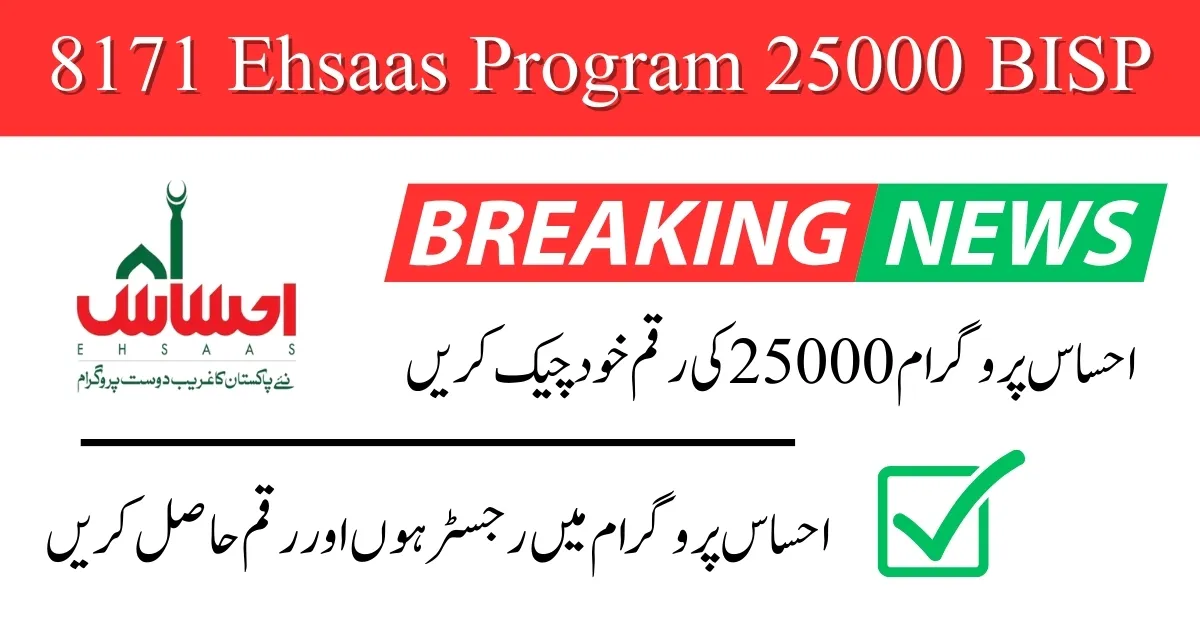The Ehsaas Program, launched by the Government of Pakistan, is a comprehensive social protection and poverty alleviation initiative aimed at supporting the country’s most vulnerable populations. The program’s overarching goal is to reduce inequality, invest in people, and lift millions out of poverty. Integral to this initiative is the Benazir Income Support Program (BISP), which has been a cornerstone of financial assistance for low-income families since its inception. The 8171 Ehsaas Program 25000 BISP Registration combines the strengths of both programs to deliver targeted financial aid of PKR 25,000 to eligible households.
II. Objectives of the 8171 Ehsaas Program 25000 BISP Registration
The primary objective of this registration process is to provide financial assistance to low-income families, thereby promoting economic stability and alleviating poverty. Additionally, the program aims to empower women and marginalized groups by ensuring that they receive direct financial support, enhancing their socioeconomic status and contributing to gender equality.
III. Eligibility Criteria
To benefit from the 8171 Ehsaas Program 25000 BISP Registration, applicants must meet specific eligibility criteria:
- Income threshold requirements: Families must fall below a certain income level to qualify.
- Residency requirements: Applicants must be Pakistani residents.
- Documentation and verification process: Necessary documents include national ID cards and proof of income.
- Criteria for women and marginalized groups: Special consideration is given to households led by women or individuals from marginalized communities.
IV. Registration Process
The registration process is designed to be accessible and straightforward, with multiple avenues available for applicants:
- Online Registration via 8171 Portal: Applicants can register online through the 8171 portal. This process involves filling out a form with personal and financial information and uploading necessary documents.
- In-person Registration Centers: For those without internet access, registration centers are set up across various locations. Staff at these centers assist applicants in completing the registration process.
- Mobile Registration Units: To reach remote areas, mobile units travel to different regions, ensuring that even the most isolated communities can register for the program.
V. Verification and Approval
Once an application is submitted, it undergoes a thorough verification process:
- Initial screening: Preliminary checks are conducted to ensure the application is complete and meets the basic eligibility criteria.
- Field verification process: Field officers visit applicants’ homes to verify the information provided.
- Final approval and notification: Successful applicants are notified through SMS or direct contact, confirming their approval and the next steps.
VI. Distribution of Funds
Funds are distributed through various methods to ensure accessibility and convenience:
- Bank transfers: Direct deposits into applicants’ bank accounts.
- Mobile wallets: Transfers to mobile banking accounts for those without traditional bank accounts.
- Cash disbursement points: Physical locations where recipients can collect their funds.
The timeline for receiving funds is typically communicated upon approval, and monitoring mechanisms are in place to ensure funds are used appropriately.
VII. Impact and Benefits
The program has had a significant positive impact on recipients:
- Case studies and success stories: Numerous families have shared how the financial assistance has helped them cover essential expenses, start small businesses, and improve their quality of life.
- Economic impact analysis: The infusion of funds into low-income households boosts local economies and stimulates demand for goods and services.
- Social impact on women and marginalized communities: Direct financial support empowers women, fostering greater gender equality and social inclusion.
VIII. Challenges and Solutions
Despite its success, the program faces several challenges:
- Common challenges: Issues such as incomplete documentation, difficulty in accessing registration centers, and delays in fund disbursement.
- Measures to address and mitigate challenges: The government has implemented solutions such as simplifying documentation requirements, increasing the number of registration centers, and improving the efficiency of the disbursement process.
- Feedback mechanisms: Continuous improvement is facilitated by collecting feedback from recipients and addressing their concerns promptly.
IX. Conclusion
The 8171 Ehsaas Program 25000 BISP Registration represents a vital lifeline for Pakistan’s most vulnerable populations. By providing financial assistance to low-income families, the program not only alleviates immediate economic hardships but also contributes to long-term socioeconomic development. Eligible individuals are encouraged to register and take advantage of the support available, helping to build a more equitable and prosperous society.
